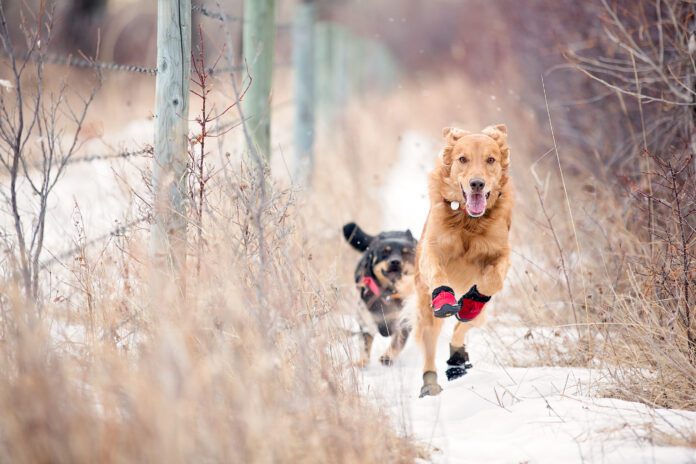Most of the time, dogs don’t need shoes, boots, or socks. Their pads are tough enough for almost any surface and in all but extreme temperatures. There are times, however, when a set of well-fitting dog shoes will be welcomed by humans and canines alike.
Dog Shoes for the Winter
According to a 2011 study from Yamazaki Gakuen University in Japan, a dog’s feet can withstand freezing temperatures due to the dog’s unique circulatory system. In dog feet, veins and arteries are set close to each other and the blood in the arteries warm the cooler blood in the dog’s veins, helping to keep the body temperature in the paws balanced.
But there are limits, and dogs vary with what cold temperatures they can handle. A dog who is starting to lift a paw, alternating paws, keeps looking at his paw, or simply sits down so he can lift all four paws off the ground is experiencing discomfort.
The problem could be snowballs forming between his pads (clipping the hair in that area can reduce the chance of that happening), freezing temperatures, injuries from rough terrain, or irritation from crusty ice or snow, or ice-melt products, all of which may be prevented with boots.
Dog Shoes for Summer
In warm weather, stinging goats’ heads, foxtails, and other burrs can stick to the hair between the dog’s pads and make walking painful. Similarly, if the dog is walking over hot surfaces like sidewalks or blacktopped surfaces, his paws can get burned. A protective boot may help.
Getting Dog Shoes to Fit Properly
Finding boots that stay on and fit well can be a challenge. Follow manufacturer instructions carefully to obtain an accurate measurement of the dog’s paw length and width to get the right fit. You may need to experiment with different types and brands to find the one just right for your dog. If you can, go to a local store where you can try the boots on the dog.
Be prepared that your dog may take time to adjust to the boots because boots, even socks, affect dogs’ proprioception, his ability to “read” the ground under them. In addition, a study in the July 12, 2022, issue of Frontiers of Veterinary Science found that wearing dog boots does orthopedically impact the dog’s ground reaction forces (the force from the ground when a body contacts it) and center of pressure (load distribution in the dog’s paw). The researchers concluded that more research was needed, but there is an effect.






All good points! Thank you, John.
My Polly (6 yr. old Golden) holds her feet up when the temp. is below 15 F (-10 C) or when there is salt on the sidewalk. And iceballs are an issue in snow – the heat of her paws turns the snow into ice between her pads.
But I have various types of boots for her and change them up, depending on the conditions. A mitt dryer is invaluable for drying the boots after you use them!
The rubber “bubble” boots, that are available in packs of 12, are great for warmish days (over 15 F) to protect against salt on the sidewalks.
The Dollar Store sells little neoprene-type boots which are good for days when the temperature is below 15 F (-10 C). They are not very sturdy, or fully waterproof, but work well for just going out in the back yard on cold days.
And Polly has fantastic boots with reinforced soles and higher “socks” that are great for deep snow, cold weather, and running.
It is so worth it! She is happy and comfortable, no matter the weather.